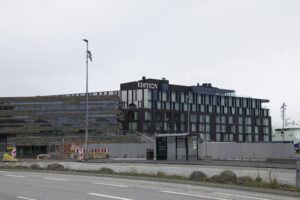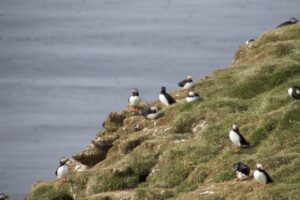By Bill Page, Class of 2001
Photographs by Jan Page except as noted
In June, my wife Jan and I visited Iceland, a fascinating country. Our tour was a cruise, with stops every day along the west coast and north to the Arctic Circle. We added another sightseeing pre-tour along the south coast. The weather was lightly rainy the first few days and mostly clear by the last, with temperatures in the mid-50s throughout. We were well-prepared to stroll, hike, and enjoy each of our many stops.
Reykjavik, the capital and largest city, is visually exciting, but except for a few standouts, specific building information is hard to find on line. Oh, it’s easy to come up with photos and more photos, but the captions only identify who took the pictures, not who designed or built the structures or what materials were used. It’s also worth noting that the Icelandic language uses a somewhat different alphabet, many long compound words (as with German, though the languages are unrelated), and a profusion of diacritical marks. For this article, I’ll stick with letters more familiar to us English-first locals.
So let’s start with those standout buildings.
The Harpa Concert Hall and Conference Center is certainly one of them. Opened in 2011 and designed by Olafur Eliasson, Henning Larssen architects and Batteri architects, it’s stunning inside and out. Here’s a view of the exterior:

And here are views of the interior walls and ceilings:
Close by are two other eye-catchers, Landsbankinn and EDITION.

The former, Iceland’s largest bank, opened just recently, designed by C.F. Moller and Arching, The exterior stone appears to be basalt, echoing the volcanic walls and cliffs that are so visible and striking outside the city. The latter, a 2022 hotel, was designed by T.ark in conjunction with the New York design firm Roman and Williams.
The tallest building in Reykjavik, at 73 meters (287 feet), is Hallgrímskirkja, an impressive 20th century church built of concrete and clad in white granite. The design was selected from a competition (we know how that can work) announced in 1929. State architect Gudjon Samuelson started work in 1937, construction began in 1945, and the structure was completed and consecrated in 1986.

The larger of the two organs is itself visually exciting. Inaugurated in 1992, it was built by Johannes Klaus Organworks in Bonn, Germany.

Another marvel inside and out is the Perlan interactive natural history museum, which includes tectonic exhibits, an ice cave (very cold and fascinating), and a Northern Lights sky show. (No, we didn’t directly see the Northern Lights; it was the week of the summer solstice, and we never saw a night sky.) The exhibit and show styles reminded me a bit of favorite Chicago museums, but of course they stand beautifully on their own.

A few other buildings grabbed my attention, but I was unable to learn more about them. Here’s a residential building near the waterfront.

Just down the street is this group that includes a commercial art gallery founded in 2019 by Olafur Eliasson.

Reykjavik also displays a sculpture called Solfario, or The Sun Voyager, which artist Jon Gunnar Arnason (who’d died shortly before construction was completed in 1990) described as “an Ode to the sun or a Dreamboat.” Our guide called it a tribute to a Viking ship.

Even before my architecture hunt, our visit to Reykjavik began, as many of our visits begin, with a food tour, which included a couple local delicacies: fermented shark with a shot of vodka/tequila/rotgut, and a “hot dog with everything,” which in Iceland means a lamb sausage on a bun with raw and fried onions, distinctive ketchup and sweet brown mustard, and remoulade. It’s definitely not a Chicago dog and definitely worth having, which I did again two more times. I had the shark-and-a-shot a second time too, but that’s a lesser memory.

Getting even further from buildings and cities, but fun to show, are some Arctic Circle markers, including the authentically-located Orbus et Globus:
Those above-mentioned volcanic cliffs:

The Great Geyser that gives the others their name, during and right after spewing, from a lot closer than is allowed at Old Faithful:
And a small sample of the many marvelous waterfalls:

Finally, no trip to Iceland would be complete without puffins:

So there you go, and I recommend you do.
CLICK HERE for more stories on The Bridge.










Thanks, Bill, for a wonderful travelogue. I’m intrigued by all of it but more impressed with the modern architecture in the capital city. I think this should go on my bucket list of places to visit.
Thanks for sharing your delightful tour, Bill! I’ve only passed through Reykjavik. Now I am more encouraged to indulge in a lengthy visit there, including to the Arctic. I especially would love to see the works by Olafur Eliasson, and to (possibly) play with the puffins. I’m unsure about that shark dish though.
And no trip should be complete without a visit to one of Iceland’s geothermal lagoons — we did the newer Sky Lagoon in Reykjavik on our visit last year; the Blue Lagoon which is near the airport has been closed periodically over the past year due to seismic activity in its area. Hope you also had the chance to enjoy the ritual of a dip into ice-cold water followed by the warmth of the lagoon!
—